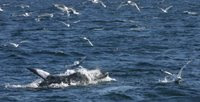So where are we in the plan? Yesterday we did our ‘box’ surveys (more like an oval) of the flat site. So towing the ‘scanfish’ temperature profiler through the water column while recording the fish acoustics & watching for seabirds. We had expected this site to be pretty dull, predicting few fish and little feeding activity (expecting more productivity on the bank than off it). However, it was a fish hotspot (we saw sandeels at the surface at night from the back of the ship) and the day was filled with diving feeding gannets – which is a sight to behold… the gannets hover high up in the sky looking down at the sea, spot a fish, tuck up their wings and plunge beak first into the sea (looks painful).
Despite having more fish & feeding activity than we hypothesised… ahah, a new theory reveals itself… Mark Inall’s drogue (‘underwater parachute used to track currents’) showed that the combination of southerly winds & tidal flow resulted in a net flow from the Jones Bank off to the southeast – directly into the waters where we had stationed our ‘control’ flat site ‘MS4’. This means that the intense mixing that occurs over the edges of the bank is swept over this area, thus increasing productivity in the vicinity… well that’s our current theory. So slight change of plan… we’re going to do another station at the other side of the bank, and this time we theorise there won’t be many fish or feeding birds (the new ‘MS5’). Fun stuff! New discoveries daily :o) Well until this theory is dashed by new data (that’s science for you – it’s more fun when the sea reveals surprises!).
Talking of new discoveries… check out the 1.6m (5’ 3’’ to those imperial – basically my height!) conger eel captured on Inigo’s camera at MS4!!!! Whoa! One massive eel! In fact the majority of the bait had been devoured within a few hours by what look like very small amphipods (think of them as sea fleas) – which was very different from the other deployments on the bank (see previous blog). The conger eel came along to mop up the remains.
 Yesterday, one highlight of the day was the passing of the Queen Mary II cruise liner – which drew quite a crowd, including ‘muf’ Claire (‘enzyme queen’ who is looking at nutrient limitation for plankton. Plankton take up phosophorous, an essential element, differently dependent on whether there is a lot around or not much around – thus by using enzymes Claire can tell whether the plankton on/off the bank have received enough nutrients or not… why is this important? Well it tells us a bit about nutrient uptake where there is more or less turbulence. You’d expect them to be less nutrient-limited where there is more turbulent mixing. Hopefully I’ve got that right!). Anyway ‘muf’ Claire is pictured here with the Queen Mary in the palm of her hand (muf is the name of the chemicals she uses for her enzyme experiments just in case you were wondering).
Yesterday, one highlight of the day was the passing of the Queen Mary II cruise liner – which drew quite a crowd, including ‘muf’ Claire (‘enzyme queen’ who is looking at nutrient limitation for plankton. Plankton take up phosophorous, an essential element, differently dependent on whether there is a lot around or not much around – thus by using enzymes Claire can tell whether the plankton on/off the bank have received enough nutrients or not… why is this important? Well it tells us a bit about nutrient uptake where there is more or less turbulence. You’d expect them to be less nutrient-limited where there is more turbulent mixing. Hopefully I’ve got that right!). Anyway ‘muf’ Claire is pictured here with the Queen Mary in the palm of her hand (muf is the name of the chemicals she uses for her enzyme experiments just in case you were wondering). Today we’ve been sitting in one spot carrying out turbulence profiling (the chimney brush or toilet brush as many of us call it) – back at the bank slope (MS2) measuring the turbulence through the water column but this time during the neap tides. And as we’d expect there is no internal wave activity at all with the tidal cycle (nothing visible on the fish echosounder anyway). Nice and predictable. Meanwhile we had some great sightings of a couple of sunfish who cruised around the ship flapping their fins & giving us great views (the photo doesn’t do it justice!). And we’re still here, with the profiler going up and down the water column every 5 minutes (operated manually by 3 or 4 people – painstaking!), and I sit here and watch the fish behaviour change as we go from day (more fish towards the bottom) to night (migrate to the surface).
Today we’ve been sitting in one spot carrying out turbulence profiling (the chimney brush or toilet brush as many of us call it) – back at the bank slope (MS2) measuring the turbulence through the water column but this time during the neap tides. And as we’d expect there is no internal wave activity at all with the tidal cycle (nothing visible on the fish echosounder anyway). Nice and predictable. Meanwhile we had some great sightings of a couple of sunfish who cruised around the ship flapping their fins & giving us great views (the photo doesn’t do it justice!). And we’re still here, with the profiler going up and down the water column every 5 minutes (operated manually by 3 or 4 people – painstaking!), and I sit here and watch the fish behaviour change as we go from day (more fish towards the bottom) to night (migrate to the surface).To finish - here is a closer shot of the Queen Mary - for you Mom! (I know it's QMII not QMI but thought it might bring back some memories).




No comments:
Post a Comment